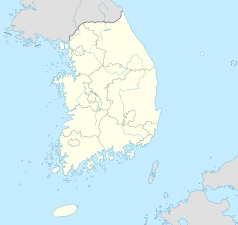Chogye sa
| Ten artykuł od 2015-10 wymaga zweryfikowania podanych informacji. |
 Główny budynek klasztoru | |
| Państwo | |
|---|---|
| Miejscowość | Seul |
| Rodzaj klasztoru | klasztor buddyjski |
| Właściciel | chogye |
| Typ zakonu | męski |
| Materiał budowlany | drewno |
| Data budowy | 1395 |
Chogye sa (조계사) – główny klasztor szkoły sŏn największego koreańskiego zakonu chogye.
Historia klasztoru
Klasztor został założony w roku 1395 a więc na samym początku antybuddyjskiej dynastii Chosŏn w innej lokalizacji pod nazwą Gakhwang. W 1910 roku klasztor został przeniesiony w obecne miejsce i po zmodernizowaniu nosił nazwę Hwanggak sa. Do jego budowy w Seulu przyczynili się japoński misjonarz i mnich sōtō Hanshi Takeda oraz patriarcha Yi Hǒgwang. Po zajęciu Korei przez Japończyków zmienili oni nazwę na T'aego sa. W 1954 roku zmieniono nazwę na Chogye sa. Chogye jest koreańskim odpowiednikiem nazwy góry na której znajdował się klasztor Szóstego Patriarchy Huinenga – Caoxi (曹溪).
Oprócz tego, że jest to główny klasztor tradycji chogye, administruje także 187 innymi klasztorami.
Adres klasztoru
- 45 Gyeonji-dong, Jongno-gu, Seul 110-170, Korea Południowa
Linki zewnętrzne
- http://www.youtube.com/watch?v=Ge2lFllP6s8 Filmik
- http://www.youtube.com/watch?v=UnK_9kpGK5M Filmik
- http://www.youtube.com/watch?v=tj4Rv0qyRPs Filmik
- http://www.youtube.com/watch?v=Rw7sJVgobIU Filmik
- http://www.youtube.com/watch?v=XyBeGpI-58E Filmik
- http://www.youtube.com/watch?v=TfEabPDxsbQ Filmik
Galeria
Media użyte na tej stronie
Symbol klasztoru do legendy mapy
Autor: Steve46814, Licencja: CC BY-SA 3.0
Jogyesa is the headquarters of the Jogye Order of Korean Buddhism playing the defining role of Seon Buddhism in South Korea. The temple was first established in 1395, at the dawn of the Joseon Dynasty. Natural monument 9, an ancient white pine tree, is located within the temple grounds.
Autor: Steve46814, Licencja: CC BY-SA 3.0
Jogyesa is the headquarters of the Jogye Order of Korean Buddhism playing the defining role of Seon Buddhism in South Korea. The temple was first established in 1395, at the dawn of the Joseon Dynasty. Natural monument 9, an ancient white pine tree, is located within the temple grounds.
Autor: Steve46814, Licencja: CC BY-SA 3.0
Jogyesa is the headquarters of the Jogye Order of Korean Buddhism playing the defining role of Seon Buddhism in South Korea. The temple was first established in 1395, at the dawn of the Joseon Dynasty. Natural monument 9, an ancient white pine tree, is located within the temple grounds.
Autor: Steve46814, Licencja: CC BY-SA 3.0
Jogyesa is the headquarters of the Jogye Order of Korean Buddhism playing the defining role of Seon Buddhism in South Korea. The temple was first established in 1395, at the dawn of the Joseon Dynasty. Natural monument 9, an ancient white pine tree, is located within the temple grounds.
Autor: Steve46814, Licencja: CC BY-SA 3.0
Jogyesa during Buddha's Birthday Fesitval. Jogyesa is the headquarters of the Jogye Order of Korean Buddhism playing the defining role of Seon Buddhism in South Korea. The temple was first established in 1395, at the dawn of the Joseon Dynasty. Natural monument 9, an ancient white pine tree, is located within the temple grounds.
Autor: Steve46814, Licencja: CC BY-SA 3.0
Jogyesa is the headquarters of the Jogye Order of Korean Buddhism playing the defining role of Seon Buddhism in South Korea. The temple was first established in 1395, at the dawn of the Joseon Dynasty. Natural monument 9, an ancient white pine tree, is located within the temple grounds.
Autor: Steve46814, Licencja: CC BY-SA 3.0
Jogyesa Bell Pavilion. Jogyesa is the headquarters of the Jogye Order of Korean Buddhism playing the defining role of Seon Buddhism in South Korea. The temple was first established in 1395, at the dawn of the Joseon Dynasty. Natural monument 9, an ancient white pine tree, is located within the temple grounds.
Autor: Steve46814, Licencja: CC BY-SA 3.0
Jogyesa is the headquarters of the Jogye Order of Korean Buddhism playing the defining role of Seon Buddhism in South Korea. The temple was first established in 1395, at the dawn of the Joseon Dynasty. Natural monument 9, an ancient white pine tree, is located within the temple grounds.
Autor: Isewell, Licencja: CC BY-SA 3.0
Worshipers at Jogyesa Temple, Seoul, Korea More Seoul pictures here
Jogyesa One Pillar Gate. The hanging board above the gates reads "The Head Temple of the Korean Jogye Order, Jogyesa." One Pillar Gates normally have a single pillar on either side making the 12 columns on this gate unusual. The One Pillar Gate represents the boundary between the spiritual world of the temple and the secular world outside.
Autor: NordNordWest, Licencja: CC BY-SA 3.0
Location map of South Korea
Autor: Steve46814, Licencja: CC BY-SA 3.0
Jogyesa is the headquarters of the Jogye Order of Korean Buddhism playing the defining role of Seon Buddhism in South Korea. The temple was first established in 1395, at the dawn of the Joseon Dynasty. Natural monument 9, an ancient white pine tree, is located within the temple grounds.
Autor: Severin.stalder, Licencja: CC BY-SA 3.0
The three buddha statues in Jogyesa Temple in Seoul.


























